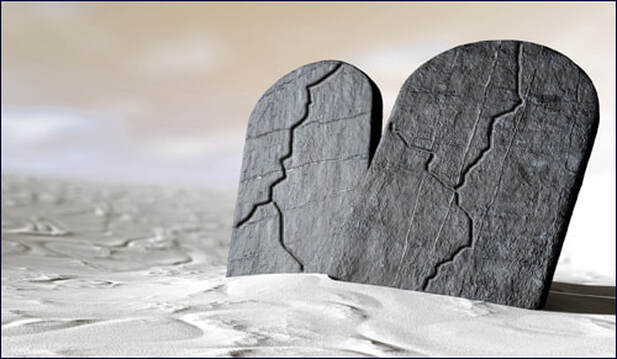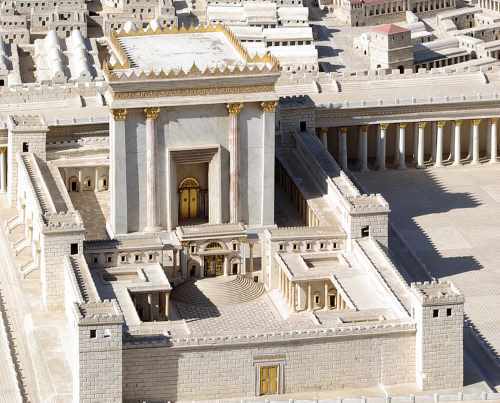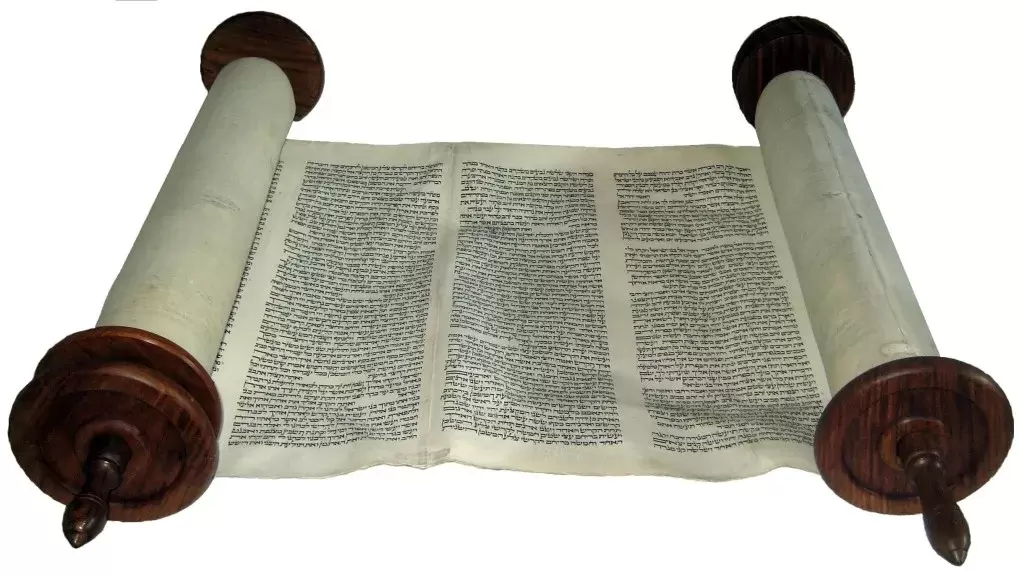 Rabbi David Etengoff ה' יעזור וירחם על אחינו כל בני ישראל, בארץ ישראל ובכל חלקי הארץ Our parasha contains a famous verse that depicts Moshe’s act of destroying the first set of luchot as a response to the Egel HaZahav (Golden Calf) and the abandoned celebration it engendered: “Now it came to pass when he drew closer to the camp and saw the calf and the dances, that Moshe’s anger was kindled, and he flung the tablets from his hands, shattering them at the foot of the mountain.” (Sefer Shemot 32:19, this and all Tanach translations, The Judaica Press Complete Tanach). In his Commentary on the Torah, the Malbim (Rabbi Meir Loeb ben Yechiel Michel, 1809-1879) intimates that Moshe certainly had every reason to destroy the luchot prior to this juncture. After all, Hashem had explicitly informed him: And Hashem said to Moshe: “Go, descend, for your people that you have brought up from the land of Egypt have acted corruptly. They have quickly turned away from the path that I have commanded them; they have made themselves a molten calf! And they have prostrated themselves before it, slaughtered sacrifices to it, and said: ‘These are your gods, O Israel, who have brought you up from the land of Egypt.’” (32:8-9) Why, then, did Moshe wait to break the luchot until “he drew closer to the camp and saw the calf and the dances?” In my estimation, the Malbim’s response is an analytic tour de force: …for he [Moshe] thought they did this [the Egel HaZahav] because they believed Moshe tarried on his way down from [Har Sinai] and sought a leader in his place. [Moreover, Moshe was convinced] when the people would see him coming down the mountain, they would cease their [forbidden] actions and repent. When he approached the camp, however, and saw they recognized him and nonetheless continued to rejoice over the Egel through their dances, he realized they were fully intent on rebelling against Hashem and Moshe His servant. Moreover, they were not merely looking for a substitute leader and guide, instead, they were engaging in literal idol worship. At that moment, Moshe became furious, and threw the luchot from his hands. (Translation and brackets my own) Even though Hashem told Moshe the people had acted corruptly, rejected the path He had commanded them, created a molten calf, bowed down before it and offered sacrifices to it, the Malbim maintains that Moshe did not initially share Hashem’s perception of the people’s actions. Instead, he believed the people were desperate for a substitute leader and guide who would lead them forward. In addition, he was positive that when the people would see him standing before them, they would cease their abhorrent ways and do teshuvah. Unfortunately, both of these assumptions proved false, for even when they saw Moshe standing in front of them, with the luchot in his hands, they continued their licentious celebrations before the Egel. This idolatrous behavior was a flat-out rebellion against Hashem and Moshe, and too great a burden for Moshe to bear. As such, “at that moment, Moshe became furious, and threw the luchot from his hands.” In his Commentary on the Torah, Rav Moshe Alshich (1508-1593) suggests an interpretation of Moshe’s hesitation to shatter the luchot that supports the Malbim’s analysis. The Alshich HaKadosh opines that our narrative is the proof text for the notion that, “a man will not act, even if he knows of the evil, until he sees it with his own eyes.” This is the case, since “the Holy One blessed be He had told Moshe [of the people’s backsliding,] and he had heard of the matter from Yehoshua, yet it did not make a crystal-clear impression upon him until he saw the Egel, for then and only then did, ‘Moshe became furious’ [and break the luchot].” The Alshich HaKadosh offers a second insightful interpretation as to why Moshe Rabbeinu did not destroy the luchot until he witnessed the decadence of the people. He notes that the essence of serving Hashem is to act, “b’simcha u’btuv lavov—in joy and with the goodness of one’s heart.” So, too, if an individual violates the will of the Holy One may He be blessed, and feels remorse for his or her actions, then there is hope that they will repent and fix the error of their ways. Sadly, however, “the person who celebrates their purposeful sin loses all hope, chas v’shalom.” The Alshich utilizes this principle to explain why and when Moshe smashed the luchot: As such, when [the sin of the Egel HaZahav] was relayed to him [Moshe] by the Almighty, Himself, He did not tell him that they [the people] were joyous and devoid of feelings of remorse regarding their sin, and, therefore, Moshe was not very angry [as he thought there was still hope for them]. When, however, he saw the Egel, the wild dancing and their overwhelming joy on their day of idol worship, then “Moshe became furious,” [as he feared the Jewish people would be no more]. With Hashem’s help, may we ever be counted among those who serve Hashem “b’simcha u’btuv lavov.” As Dovid HaMelech said so long ago: “Serve Hashem with joy (b’simcha), come before Him with praise.” (Sefer Tehillim 100:2) V’chane yihi ratzon. Shabbat Shalom Past drashot may be found at my blog-website: http://reparashathashavuah.org. Please contact me at [email protected] to be added to my weekly email list. *** My audio shiurim on the topics of Tefilah and Tanach may be found at: http://tinyurl.com/8hsdpyd *** I have posted 164 of Rabbi Soloveitchik’s English language audio shiurim (MP3 format) spanning the years 1958-1984. Please click on the highlighted link: The Rav
0 Comments
 Rabbi David Etengoff ה' יעזור וירחם על אחינו כל בני ישראל, בארץ ישראל ובכל חלקי הארץ The notion of Hashem dwelling amongst our people is presented in two pasukim in Sefer Shemot. The first appears in last week’s parasha, “And they shall make Me a sanctuary (mikdash) and I will dwell (v’shachanti) in their midst;” and the second in our Torah portion, “I will dwell (v’shachanti) in the midst of the children of Israel, and I will be their G-d (v’hayiti lahem l’Elokim).” (25:8 and 29:45, translation, The Judaica Press Complete Tanach) The first pasuk states that as a result of constructing the Mishkan the Holy One blessed be He will dwell among us, and the second adds the idea that His dwelling in our midst indicates He will be our G-d. As such, the following formula emerges: Construction of the Mishkan eventuates in v’shachanti among us, which leads to v’hayiti lahem l’Elokim. Although they seem to convey similar content, v’shachanti, and v’hayiti lahem l’Elokim are actually dissimilar concepts. This approach was followed by both the Sforno (Rabbi Ovadiah ben Ya’akov,1475-1550) and the Netziv (Rabbi Naftali Tzvi Yehudah Berlin, 1816-1893) in their respective Torah commentaries on Sefer Shemot 29:45. According to the Sforno, v’shachanti refers to Hashem’s ready desire to accept our tefilot, and our avodah (korbanot). In contrast, v’hayiti lahem l’Elokim, gives voice to the idea that Hashem will do so bikvodo u’vatzmo, that is, without any intermediary. This is similar to how He took us out from Egypt: “Not through the efforts of an angel (malach), not through the exertions of a ministering angel (saraf) and not as a result of a messenger (shaliach), rather, by the Holy One blessed be He, in His honor and glory.” (Haggadah) The Netziv differs from the Sforno’s interpretation of “v’shachanti in our midst,” and suggests it denotes an everlasting connection between Hashem and the Jewish people—even when we are not zocheh to have the Mishkan: Even in the absence of the Mishkan, wherein Hashem’s glory, may He be blessed, was explicitly manifest, [He] will continue to ever be in the midst of the Jewish people. This means that His Schechinah (Divine Presence) will never depart from the community of Israel…even though it will not appear manifestly evident to all. (Translation my own) Moreover, unlike the Sforno, the Netziv suggests that “v’hayiti lahem l’Elokim” signifies the Almighty is continually attuned to and “watchful of our needs and will fulfill them.” Whether we follow the Sforno or the Netziv, both agree that v’shachanti and v’hayiti lahem l’Elokim refer to Hashem’s commitment to an eternal personal relationship with the Jewish people. In my view, this is the counterpoint to our passionate song at the Yam Suf: “This is my G-d and I will ever praise him (zeh kali v’anvahu), the G-d of my father, and I will exalt Him.” (Sefer Shemot 15:2) We were G-d intoxicated at the Yam Suf and could not hold ourselves back from bursting out in a song of ever-lasting love to Him; now, so to speak, it is Hashem’s turn to proclaim His never-ending love for the Jewish people. On measure, this analysis lends new meaning to the oft-said phrase: “Ashreinu mah tov chelkeinu u’mah nayim goraleinu u’mah yafah yerushateinu—We are overjoyed in the goodliness of our portion! And how pleasing is our fate! And how desirous is our inheritance!” The terms portion, fate and inheritance refer to the holy Torah and the dynamic relationship it fosters between Hashem and the Jewish people. Therefore, let us proclaim, “zeh kali v’anvahu,” and may we once again be blessed to hear, “v’shachanti v’hayiti lahem l’Elokim!” V’chane yihi ratzon. Shabbat Shalom Past drashot may be found at my blog-website: http://reparashathashavuah.org They may also be found on http://www.yutorah.org/ using the search criteria of Etengoff and the parasha’s name. The email list, b’chasdei Hashem, has expanded to hundreds of people. I am always happy to add more members to the list. If you have family or friends you would like to have added, please do not hesitate to contact me via email mailto:[email protected]. *** My audio shiurim for Women on the topics of Tefilah and Tanach may be found at: http://tinyurl.com/8hsdpyd *** I have posted 164 of Rabbi Soloveitchik’s English language audio shiurim (MP3 format) spanning the years 1958-1984. Please click on the highlighted link.  Rabbi David Etengoff ה' יעזור וירחם על אחינו כל בני ישראל, בארץ ישראל ובכל חלקי הארץ The best-known pasuk in our parasha is, “And they shall make Me a sanctuary (mikdash) and I will dwell in their midst.” (Sefer Shemot 25:8, this, and all Bible translations, The Judaica Press Complete Tanach) It is followed by many verses that specify every possible detail of the constitutive elements of the Mishkan. Yet, as the Mechilta d’Rabbi Yishmael notes, the very act of constructing a mikdash for Hashem is problematic: “And they shall make Me a sanctuary and I will dwell in their midst;” why was this ever stated? After all, was it not already said, (Sefer Yirmiyahu 23:24) ‘Behold I fill the heavens and the earth?’ [As such, how can any dwelling contain Hashem?]” (Translation and brackets my own) The Mechilta d’Rabbi Yishmael teaches us the idea of building a mikdash for Hashem seemingly makes no sense. This is similar in kind to Yeshayahu’s famous declaration: “So says Hashem, ‘the heavens are My throne, and the earth is My footstool; which is the house that you will build for Me, and which is the place of My rest?’” (Sefer Yeshayahu 66:1) The great Lithuanian Torah sage, Rav Chaim of Volozhin (1749-1821), was acutely aware of the conceptual challenges posed by the mitzvah to build a mikdash for Hashem. He addressed them by emphasizing the later part of our pasuk, “and I will dwell in their midst,” and suggests this revolutionary interpretation: Behold, there is no doubt whatsoever, that the very idea of the holy (hakodesh), the sanctuary (hamikdash) and the in-dwelling (shriyat shechinato) of the Holy One blessed be He refers to man, himself. [This is the case,] for if he sanctifies himself in the proper manner through the fulfillment of all the mitzvot…then he, himself, will be the sanctuary of Hashem (hu atzmo hamikdash mammash) and within him will be Hashem, may His Name be blessed. (Nefesh HaChaim, I:4, this, and the following translations and brackets my own) The depth of Rav Chaim’s chiddush cannot be overestimated: If we sanctify ourselves through the performance of the mitzvot, then we will be the ultimate mikdash of Hashem. Rav Chaim bases his reasoning upon a verse from Yirmiyahu, and a well-known statement of our Sages found in the Midrash Aggadah: [As proof for what I have suggested,] we have the text from Sefer Yirmiyahu: “…The Temple of the Hashem, the Temple of Hashem, the Temple of Hashem are they.” (7:4) This is similar in kind to the utterance of our Sages, may their memory be blessed, “and I will dwell in their midst”— “It does not say, ‘in it’ [that is, the physical Mikdash,] rather it says, “in their midst,” [that is, literally within them.] At this juncture, it seems the physical structure of the Mikdash, or even of the Beit HaMikdash, is well-nigh superfluous, as it is superseded by the Jewish people, themselves. A careful reading of Rav Chaim’s next words seem to support precisely this approach: In addition, according to our manner of explanation, one should not think that the essential purpose of My [G-d’s] intention [regarding the commandment to construct the Mikdash] is the creation of the physical Mikdash itself (hamikdash hachitzoni). What, then, is the rationale inherent in the construction of the Mikdash? For Rav Chaim, it is nothing less than the creation of the greatest teaching device the world has ever known: But you should know that My [Hashem’s] overarching purpose and desire regarding the Mikdash’s construction and all its vessels, is solely to indicate to you [the Jewish people individually, and as a people,] that you should model yourselves after these physical entities and reconstruct yourselves and all of your actions, so that they will be as proper to Me as the building of the Mikdash and all its [sanctified] vessels. [For in truth,] all of you are holy, fitting, and prepared (kedoshim, re’uyim u’muchanim) for My holy presence to literally dwell within you (lehashrot shechinati b’tochchachem mammash). This, then, is the true meaning of, “And they shall make Me a sanctuary (mikdash) and I will dwell in their midst.” Rav Chaim’s message is unbelievably inspiring: We, the Jewish people, are holy and fitting for the Schechinah to dwell amongst us, for in truth, we are His mikdash. With Hashem’s help, may we rededicate ourselves to His holy Torah and the fulfillment of His mitzvot, and become His mikdash soon and in our days. V’chane yihi ratzon. Shabbat Shalom Past drashot may be found at my blog-website: http://reparashathashavuah.org Please contact me at [email protected] to be added to my weekly email list. *** My audio shiurim on the topics of Tefilah and Tanach may be found at: http://tinyurl.com/8hsdpyd *** I have posted 164 of Rabbi Soloveitchik’s English language audio shiurim (MP3 format) spanning the years 1958-1984. Please click on the highlighted link: The Rav  Rabbi David Etengoff ה' יעזור וירחם על אחינו, כל בני ישראל בארץ ישראל ובכל חלקי הארץ Na’aseh v’nishmah (we will do, and we will hear—comprehend) are two of the most celebrated words that appear in our parasha. When the Jewish people uttered this phrase during Kabbalat HaTorah, they acted like Heavenly Angels and transformed their relationship with Hashem. This idea is found in a well-known statement in Talmud Bavli: “Rabbi Simai taught: ‘When the Jewish people accorded precedence to the declaration ‘We will do’ over the declaration ‘We will hear,’ 600,000 ministering angels came and tied two crowns to each and every member of the Jewish people, one corresponding to ‘We will do’ and one corresponding to ‘We will hear.’” (Translation, The Koren Talmud Bavli, Shabbat 88a, elucidated and edited by Rabbi Adin Steinsaltz zatzal) In my estimation, na’aseh v’nishmah may be viewed as our ancestors’ proclamation of their undying belief in Moshe’s divine agency and the absolute truth of the Torah; an idea that is found in Talmud Bavli, Baba Batra 74a: “Moshe v’Torato emet.” Numerous verses in Tanach support the notion that Moshe was the shaliach v’navi Hashem par excellence. Perhaps the two most famous are found in Sefer Bamidbar 12:7-8: “Not so is My servant, Moshe; he is faithful throughout My house. With him I speak mouth to mouth; in a vision and not in riddles, and he beholds the image of Hashem.” (Translation, The Judaica Press Complete Tanach) This is not the case regarding the phrase Torato emet, as there is only one pasuk in Tanach wherein the words, “Torat emet,” are juxtaposed (Sefer Malachi 2:6). This verse, however, does not speak to the veracity of the Torah in general. Instead, it gives voice to the historical loyalty of the Tribe of Levi to Hashem and His Torah. If so, what does Torat emet denote? I believe we can understand Torat emet as signifying the eternality and unchanging nature of the Torah, a concept that the Rambam (1135-1204) explicates in his Mishneh Torah: It is clear and explicit in the Torah that it [that is, the Torah] is [Hashem’s] commandment, remaining forever without change, addition, or diminishment, as [Sefer Devarim 13:1] states: “All these matters which I command to you, you shall be careful to perform. You may not add to it or diminish from it” … This teaches that we are commanded to fulfill all the Torah’s directives forever. It is also said: “It is an everlasting statute for all your generations,” and [Sefer Devarim 30:12] states: “Lo bashamayim he.” This teaches that a prophet can no longer add a new precept [to the Torah]. (Hilchot Yesodei HaTorah IX:1, translation, Rabbi Eliyahu Touger, brackets my own) In sum, the Rambam explains the eternality of the Torah as being comprised of the following constitutive elements: 1) It is Hashem’s commandment. 2) It exists “forever without change, addition or diminishment.” 3) “A prophet can no longer add a new precept [to the Torah].” The Rambam’s formulation of the principle of the eternality of the Torah is in consonance with the following well-known Talmudic narrative: On that day Rabbi Eliezer brought forward every imaginable argument [in a highly technical dispute regarding ritual purity and impurity], but they [the other sages] did not accept them… [Said Rabbi Eliezer:] “If the halacha agrees with me, let it be proved from Heaven!” Whereupon a Heavenly Voice (bat kol) cried out: “Why do you dispute with Rabbi Eliezer, seeing that in all matters the halacha agrees with him!” But Rabbi Yehoshua arose and exclaimed: “Lo bashamayim he!” What did he mean by this? Said Rabbi Yirmiyah: That the Torah had already been given at Mount Sinai; [therefore,] we pay no attention to a Heavenly Voice (bat kol), because You [Hashem] have long since written in the Torah at Mount Sinai (Sefer Shemot 23:2), “After the majority must one follow.” (Talmud Bavli, Baba Metzia 59b, translation, The Soncino Talmud with my brackets and emendations) This Talmudic passage is nothing less than amazing. In relatively few words, it denies the possibility of a post-Sinaitic revelation. Moreover, it demonstrates that human reason, in conjunction with the accepted principles of Torah exegesis and majority rule, are the sole determinants in any halachic dispute—even when one of the disputants is a bat kol! As Rabbi Aryeh Leib HaKohane Heller (1745-1812), one of the major halachic authorities of the past two centuries opines: The Torah, however, was not given to the ministering angels, but rather to humankind who is limited to sechel enoshi (human logic and reason). And the Holy One blessed be He gave us the Torah out of the abundance of His mercy and kindness to be adjudicated according to sechel enoshi, even if it never achieves emet on the level of HaSichlayim Hanivdalim (that is, Hashem and His ministering angels). (Introduction to Ketzot HaChoshen, translation my own) Shabbat Shalom Past drashot may be found at my blog-website: http://reparashathashavuah.org Please contact me at [email protected] to be added to my weekly email list. *** My audio shiurim on the topics of Tefilah and Tanach may be found at: http://tinyurl.com/8hsdpyd *** I have posted 164 of Rabbi Soloveitchik’s English language audio shiurim (MP3 format) spanning the years 1958-1984. Please click on the highlighted link: The Rav |
Details
Archives
July 2024
AuthorTalmid of Rabbi Soloveitchik zatzal Categories |
- Blog: Rabbi David Etengoff: Parashat HaShavuah
- Sefer Bereishit 5784&5785
- Sefer Shemot 5784&5785
- Sefer Vayikra 5784&5785
- Sefer Bamidbar 5784 &5785
- Sefer Bereishit 5782&5783
- Sefer Shemot 5782&5783
- Sefer Vayikra 5782&5783
- Sefer Bamidbar 5782&5783
- Sefer Devarim 5782&5783
- Sefer Bereishit 5780& 5781
- Sefer Shemot 5780&5781
- Sefer Vayikra 5780&5781
- Sefer Bamidbar 578&5781
- Sefer Devarim 578&5781
- Sefer Bereishit 5778&5779
- Sefer Shemot 5778&5779
- Sefer Vayikra 5778&5779
- Sefer Bamidbar 5778&5779
- Sefer Devarim 5778&5779
- Sefer Bereishit 5776&5777
- Sefer Bereishit 5774&5775
- Sefer Bereishit 5772&5773
- Sefer Bereishit 5771&5770
- Sefer Shemot 5776&5777
- Sefer Shemot 5774&5775
- Sefer Shemot 5772&5773
- Sefer Shemot 5771&5770
- Sefer Vayikra 5776&5777
- Sefer Vayikra 5774&5775
- Sefer Vayikra 5772&5773
- Sefer Vayikra 5771&5770
- Sefer Bamidbar 5776&5777
- Sefer Bamidbar 5774&5775
- Sefer Bamidbar 5772&5773
- Sefer Bamidbar 5771&5770
- Sefer Devarim 5776&5777
- Sefer Devarim 5774&5775
- Sefer Devarim 5772&5773
- Sefer Devarim 5771&5770
 RSS Feed
RSS Feed
